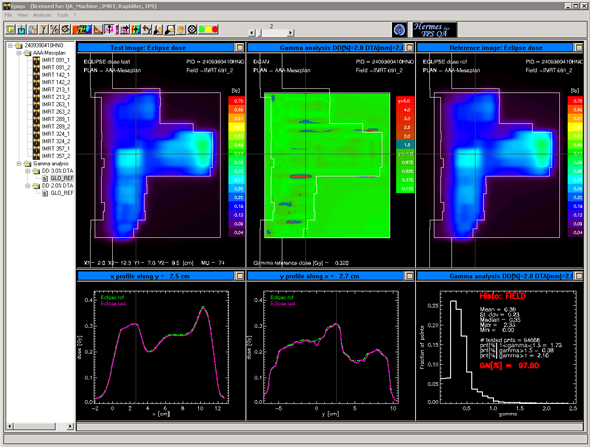EPIQA is a commercial software which we use for the independent verification of IMRT treatments with the Varian EPID (Electronic Portal Imaging Device). See the EPIdos website for details and current releases.
Evaluations were performed with version 2.1.1 or 2.1.2.

(typical EPIQA screen in version 2)
At first glance, the functionality of EPIQA seems to be similar to that of Varian Portal Dosimetry (VPD): First, verification plans for each field are calculated in Eclipse. Then the IMRT plan is delivered on the linac, where integrated images are acquired ("measured") with the EPID. Finally, calculated 2D dose distributions and measured images are compared field by field with EPIQA, typically using the gamma index method.
The main differences are:
- In VPD, predicted images are calculated in Eclipse using a special algorithm (PDIP - Portal Dose Image Prediction). This is not the algorithm that is used for calculating 3D volume dose (e.g., AAA, PBC) in clinical treatment plans. PDIP is a 2D algorithm, it is separately configured and contains separate beam data. EPIQA requires the 2D-dose matrices to be calculated in Eclipse with the same algorithm (e.g., AAA) as is used for 3D volume dose. Without doubt, this is more consistent. The EPIQA calculations are typically performed in the depth of dose maximum.
- VPD is limited to the above workflow (IMRT verification, including RapidArc). In addition to these capabilities, EPIQA can also compare Eclipse calculation with Eclipse calculation, EPID measurement with EPID measurement, and has tools for machine QA.
- In VPD, absolute values are given in a special unit: Calibrated Units or CU (100 MU = 1 CU). EPIQA converts the EPID-measured integrated images to planar dose distributions using the GLAaS algorithm, and gives results in Gy.
- VPD is integrated in ARIA, EPIQA is not. This is the main drawback of EPIQA. With VPD, there is no export or import of any files. EPIQA needs the DICOM RT treatment plan and the calculated dose distributions exported from Eclipse, plus the EPID-measured images exported from ARIA. This takes more time for preparation, errors can happen. VPD is clearly more user-friendly in the preparation phase.
- The results of the VPD analysis are automatically saved in the ARIA database, with the same high data security as patient treatments. EPIQA saves files, and the user is responsible that nothing gets lost.
- In the ARIA network, VPD can be run on any workstation where ARIA is installed. EPIQA can only run on the workstation where the USB dongle is installed1.
If time is at a premium, one will probably choose VPD. If consistency, flexibility and superior physics are important, EPIQA is the right choice. Of course, it is always good to have both ;-)
Some examples
- Eclipse: Creating the phantoms for MIX and DMAX mode
- Eclipse: Preparing for a plan verification with EPIQA (15MV, MIX mode)
- EPIQA: Gaussian convolution (15MV, MIX mode)
- EPIQA: a typical high-energy example (15MV, DMAX mode)
- EPIQA: an interesting 6MV high-resolution example (MIX mode)
- EPIQA: Comparing two calculations (Eclipse vs Eclipse)
